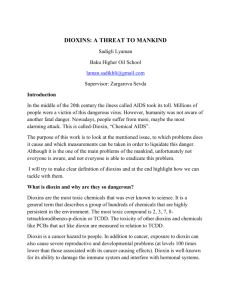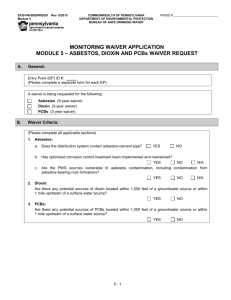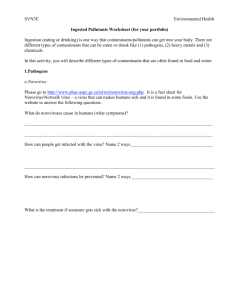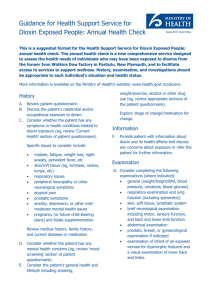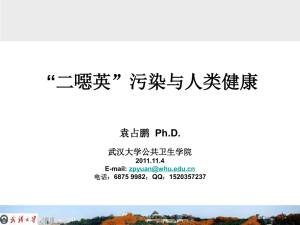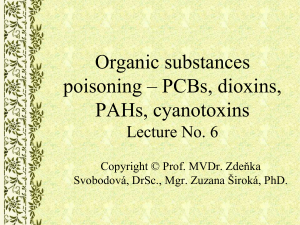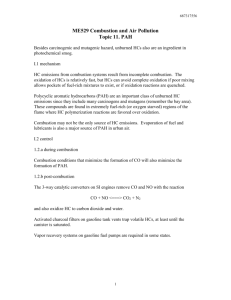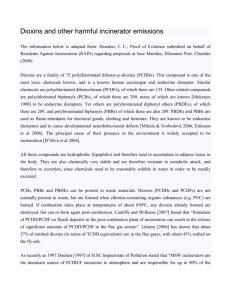DOC - Europa
advertisement
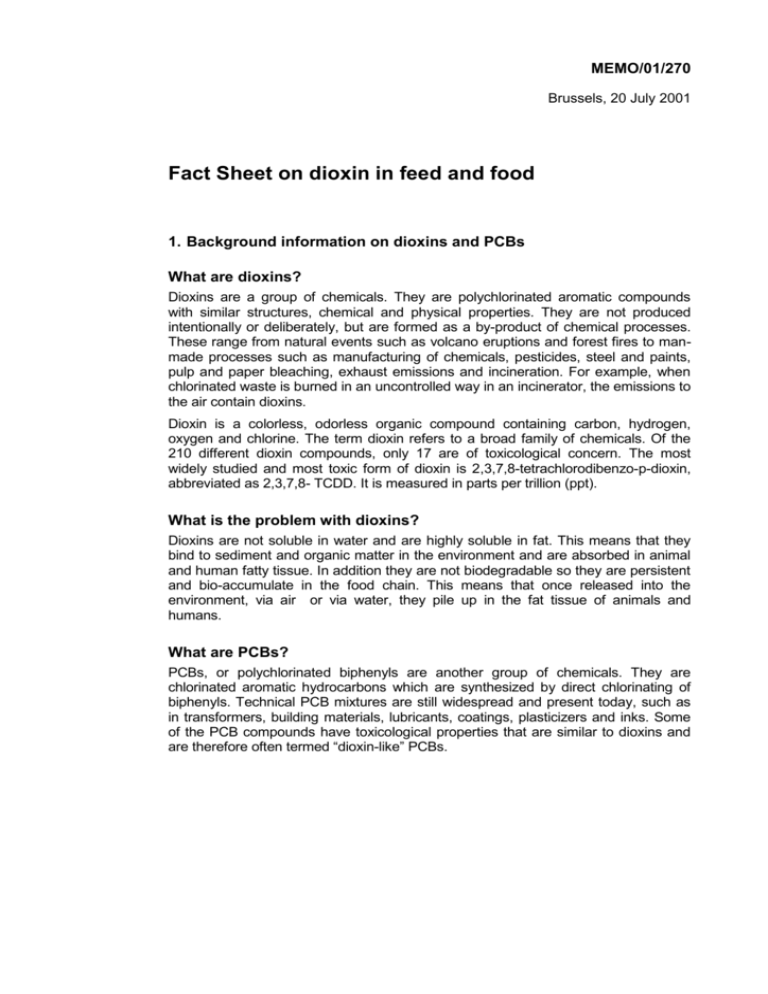
MEMO/01/270 Brussels, 20 July 2001 Fact Sheet on dioxin in feed and food 1. Background information on dioxins and PCBs What are dioxins? Dioxins are a group of chemicals. They are polychlorinated aromatic compounds with similar structures, chemical and physical properties. They are not produced intentionally or deliberately, but are formed as a by-product of chemical processes. These range from natural events such as volcano eruptions and forest fires to manmade processes such as manufacturing of chemicals, pesticides, steel and paints, pulp and paper bleaching, exhaust emissions and incineration. For example, when chlorinated waste is burned in an uncontrolled way in an incinerator, the emissions to the air contain dioxins. Dioxin is a colorless, odorless organic compound containing carbon, hydrogen, oxygen and chlorine. The term dioxin refers to a broad family of chemicals. Of the 210 different dioxin compounds, only 17 are of toxicological concern. The most widely studied and most toxic form of dioxin is 2,3,7,8-tetrachlorodibenzo-p-dioxin, abbreviated as 2,3,7,8- TCDD. It is measured in parts per trillion (ppt). What is the problem with dioxins? Dioxins are not soluble in water and are highly soluble in fat. This means that they bind to sediment and organic matter in the environment and are absorbed in animal and human fatty tissue. In addition they are not biodegradable so they are persistent and bio-accumulate in the food chain. This means that once released into the environment, via air or via water, they pile up in the fat tissue of animals and humans. What are PCBs? PCBs, or polychlorinated biphenyls are another group of chemicals. They are chlorinated aromatic hydrocarbons which are synthesized by direct chlorinating of biphenyls. Technical PCB mixtures are still widespread and present today, such as in transformers, building materials, lubricants, coatings, plasticizers and inks. Some of the PCB compounds have toxicological properties that are similar to dioxins and are therefore often termed “dioxin-like” PCBs. What are the sources of human exposure to dioxin? Dioxin is ubiquitous in the environment: it is found throughout the industrialized world in air, water and soil, as well as in food. Human exposure to dioxin can occur through working in industries where dioxin is a by-product, industrial accidents, through food, human breast milk and drinking water. Overall, skin contact or breathing represents very small sources of dioxin exposure. How does dioxin get into the food chain? Dioxin can enter the food supply through a number of different routes. The contamination of the environment by dioxins is primarily caused by the aerial transportation and deposition of emissions from various sources (waste incineration, production of chemicals, traffic, etc.). The use and disposal of chemicals can contribute to more severe localised contamination. Soil is a natural sink for dioxins. Apart from atmospheric deposition, soils may be polluted by sewage sludge or composts, spills and erosion from nearby contaminated areas. Soil is absorbed, directly or indirectly via dust deposits on vegetables, by free-range grazing cattle, goats, sheep and chicken and burrowing/grazing pig and wild boar. Aerial transport and deposition of dioxins and dioxin-like PCBs are also the main sources of contamination of leafy vegetables, pastures and roughages. Leaves are either directly grazed by free-ranging animals, or cropped and then preserved under dried form (hay) or silage. The spreading of sewage sludge on vegetation can increase to a limited extent the exposure of livestock. Dioxins and dioxin-like PCBs are poorly soluble in water, but are adsorbed onto mineral or organic particles in suspension in water. When dioxins emissions are transported by air to the surface of oceans and seas they end up concentrating along the aquatic food chain. Dioxin concentrates in the fatty tissues of beef and dairy cattle, poultry, pork or seafood. Theoretically, the longer the life span of an animal, the higher potential accumulation of dioxin in its adipose tissue. Which food products are most affected? In general, food of animal origin contributes to about 80% of the overall human exposure. The contamination can vary widely depending on the origin of the foodstuff. Meat, eggs, milk, farmed fish and other food products may be contaminated above background levels by dioxins from feedingstuffs. Such contamination may be due to a high level of local environmental contamination, for example from a local waste incinerator, to incidents, such as in 1999 in Belgium, or to a high content of dioxins in fishmeal and fish oil. Wild fish from certain polluted areas may be highly contaminated. Is dioxin contamination getting worse? From the available data it appears that the background exposure to dioxin and dioxin-like PCBs of the European population has decreased over the last 10 years. 2 How does dioxin get into our bodies? We accumulate dioxins in our bodies mostly by eating dioxin contaminated food. As in animals, dioxin is stored in human adipose tissue. Certain population groups, such as nursing babies and people who eat a diet high in animal fat or in contaminated foods because of their proximity to dioxin release sites, are exposed to higher than average levels of dioxin. What is the dioxin body burden? Toxicity of dioxins is related to the amount accumulated in the body during lifetime, the so-called body burden. It is used for the assessment of toxic effects of dioxins as it is a much better estimate of the continuous exposure than the daily intake. What is the health impact of eating food contaminated with dioxins? Dioxins have a broad series of toxic and biochemical effects and some of them are classified as known human carcinogen. In laboratory animals they have been linked to endometriosis (severe effects on the uterus), developmental and neurobehavorial effects (learning disabilities), developmental reproductive effects (low sperm count, genital malformations) and immunotoxic effects. . These effects occur at much lower levels of exposure than carcinogenic effects. What about dioxin in mothers milk and breast-feeding? Is it a health threat to nursing infants? Mothers’ milk does contain elevated dioxin levels. Some dioxin is known to pass from the mother's body to the infant during lactation. However, the intake by babies from breast-feeding is restricted to a relatively short period of their lives. What is relevant for children, and not only breast-fed babies, is the amount of dioxin received from their mothers as an embryo. In this context, the SCF has reiterated the conclusions of the WHO meetings on the health significance of contamination of human milk with dioxins and PCBs, namely that the current evidence does not justify altering recommendations on the promotion of, and support for, breast-feeding. Health experts recognize that breastfeeding provides many nutritional, immunologic and other benefits to the infant in the first months of life. How is dioxin contamination of food and feed detected? A well known recent example of dioxin contamination is the Belgian dioxin contamination of feedstuff in 1999. The dioxin contamination in Belgium was detected by the direct biological health effects observed in poultry, not through a monitoring program. Four other cases of dioxin contamination (citrus pulp, kaolinitic clay, artificially dried grass meal and choline chloride) have been detected in Europe since 1997 within the framework of local monitoring programs. In response to the Belgian dioxin crisis in 1999 which involved dioxin contamination of Belgian food products via PCB contaminated feed, the EU imposed temporary restrictions on the intra and extra community trade in milk and dairy products, beef , pork, poultry, eggs and egg derivatives (mayonnaise, prepared dishes, for example) and cattle feed. 3 2. Overall EU policy approach aimed at reducing exposure to dioxin levels In follow-up to the White Paper on Food Safety of January 2000 the European Commission has been actively working towards a comprehensive strategy to deal with dioxin contamination in feed and food. The Feira European Council of June 2000 asked the Commission to propose harmonized rules for such contaminants. Two scientific opinions form the key scientific input to the development of this strategy. An opinion of the Scientific Committee on Animal nutrition (SCAN) on the “Dioxin contamination of feedingstuffs and their contribution to the contamination of food of animal origin” has been adopted on 6 November 2000 and an opinion of the Scientific Committee on Food (SCF) on the “Risk assessment of dioxins and Dioxinlike PCBs in Food” has been adopted on 30 May 2001; this latter is an update based on new scientific information which has become available since the adoption of the SCF opinion of 22nd November 2000. The Commission has now put forward to the Member States a comprehensive legislative strategy (see IP/xx/01 and below) What has the Commission done since the publication of the White paper? The Commission has requested the Scientific Committee for Food (SCF) and the Scientific Committee for Animal Nutrition (SCAN) to assess the risks for public health arising from the presence of dioxins and dioxin-like PCBs in food and feed. This includes an assessment of the dietary intake of dioxins and PCBs by the EU population, identifying the main contributors. The opinions of the SCF and the SCAN were published in November 2000. The SCF opinion was updated in May 2001. On the basis of these scientific risk assessments, the Commission is proposing measures to limit the presence of dioxins and dioxin-like PCBs throughout the whole food and feed chain (see IP/xx/01 and below) What strategy does the Commission follow? The overall goal of the European policy on dioxins is to reduce the contamination levels of dioxins and PCBs in the environment, in feed and in foodstuffs in order to ensure a high level of public health protection. This goal will be achieved by acting at all stages of the chain: - reducing the contamination levels of the environment (measures of DG Environment); - reducing the contamination of feedingstuffs, including fish feed; - reducing the contamination levels of foodstuffs. The Commission has proposed to the Member States the following legislative measures concerning feedingstuffs and foodstuffs: the establishment of maximum levels at a strict but feasible level in food and feed the establishment of action levels acting as a tool for “early warning” of higher than desirable levels of dioxin in food or feed the establishment of target levels, over time, to bring food and feed within the limits recommended by the Scientific Committees. 4 Why aren't dioxins prohibited? Dioxins are not produced intentionally. These contaminants have an ubiquitous distribution due to their formation as unwanted and often unavoidable by-products in a number of activities. So you cannot simply “prohibit dioxins”. Is there any legislation prohibiting the production and marketing of PCBs? Yes, the production and use of PCBs has been discontinued in almost all industrial countries. At Community level Directive 76/769 has prohibited the use of most PCBs as of 1978 and for certain applications as of 1986. (However, as a result of their widespread use in the past large amounts of PCBs remain present until today in electrical equipment, plastic products, buildings and in the environment. As a result PCBs are also still ending up in waste streams. Council Directive 96/59/EC on the disposal of polychlorinated biphenyls and polychlorinated terphenyls (PCB/PCT) sets a deadline for taking all PCB-containing equipment out of service by the end of 2010. 3. Dioxins in Food What are the current legislative rules on dioxin in food? Council Regulation (EEC) 315/93 of 8 February 1993 laying down Community procedures for contaminants in food provides that - food containing a contaminant in an amount which is unacceptable from the public health viewpoint and in particular at a toxicological level shall not be placed on the market; - contaminant levels shall be kept as low as can reasonably be achieved by following good practices; - maximum levels must be set for certain contaminants in order to protect public health. For the moment, there is no specific limit for dioxin or PCBs in food set at Community level as yet and only the general requirement applies. What is the opinion of the Scientific Committee for Food about? The Scientific Committee for Food (SCF) has assessed the risks for public health arising from the presence of dioxins and dioxin-like PCBs in food . This includes an assessment of the dietary intake of dioxins and dioxin-like PCBs by the EU population, identifying the main contributors. Given the persistent nature of these compounds the SCF has established a tolerable weekly intake (TWI) of 14 picogram toxic equivalents (TEQ) per kilogram body weight for dioxins and dioxin-like PCBs. This TWI is in line with the provisional Tolerable Monthly Intake (PTMI) of 70 pg/kg bodyweight/month established by the Joint FAO/WHO Expert Committee on Food Additives (JECFA) at its fifty-seventh meeting (Rome, 5-14 June 2001) and concurs with the lower end of the range Tolerable Daily Intake (TDI) of 1-4 pg WHO-TEQ/kg body weight, established by the World Health Organisation (WHO) Consultation in 1998. 5 What is Toxic Equivalent Concentration (TEQ)? Each congener of compound of dioxins or dioxin-like PCBs presents a different level of toxicity. To sum up the toxicity of these different congeners, the concept of toxic equivalency factors (TEFs) has been introduced to facilitate risk assessment and regulatory control. This means that the analytical results of all congeners or compounds of toxicological relevance (17 dioxin and 12 dioxin-like PCB congeners) are converted into one result which summarizes all and is expressed as TCDD toxic equivalent concentration” or “TEQ”. Is there a difference between the Scientific Committee for Food (SCF) opinion and the result of the JECFA and WHO Consultation on dioxins? The SCF has established a tolerable weekly intake (TWI) of 14 picogram toxic equivalents (TEQ) per kilogram body weight for dioxins and dioxin-like PCBs. This TWI is in line with the provisional Tolerable Monthly Intake (PTMI) of 70 pg/kg bodyweight/month established by the Joint FAO/WHO Expert Committee on Food Additives (JECFA) at its fifty-seventh meeting (Rome, 5-14 June 2001) and concurs with the lower end of the range Tolerable Daily Intake (TDI) of 1-4 pg WHO-TEQ/kg body weight, established by the World Health Organisation (WHO) Consultation in 1998. Comparing like with like, the SCF (May 2001) established a maximum intake of 2 pg/kg bodyweight/ day, JECFA (June 2001) 2.3 pg/kg bodyweight/ day and the WHO Consultation (May 1998) a range of 1 to 4 pg/kg bodyweight/ day. Does the SCF conclude the European population at risk? Although the SCF has concluded that a considerable part of the European population is exceeding the tolerable intake, the Committee also states that this does not necessarily mean that there is an appreciable risk to the health of individuals, because the TWI includes a safety factor. However, exceeding the TWI leads to erosion of the protection embedded in the safety factor. It is important to state that the dietary intake of individuals varies widely among Europe because of different eating habits and different food sources. For example, if you eat a diet consisting mainly of fish from highly contaminated areas such as the Baltic, the risk is much higher than when you eat a varied diet in southern Europe. 4. Dioxins in Feed What are the current legislative rules on dioxin in feed? Council Directive 1999/29/EC of 22 April 1999 on the undesirable substances and products in animal nutrition foresees that feed materials and feedingstuffs may only be put into circulation of they are "sound, genuine and of merchantable quality". Feed materials and feedingstuffs cannot be considered as sound, genuine and of merchantable quality if the level of dioxins is unacceptably high and constitutes a risk for human (and animal) health. 6 Are there currently any limits on dioxins in animal feed? Specific maximum limits for dioxins (dioxins and furans, not for dioxin-like PCBs) have been established for citrus pulp and kaolinitic clay. These limits were established on a provisional basis in 1998 and 1999 respectively and have to be reviewed in the light of the SCAN opinion of November 2000. What is in the Scientific Committee on Animal Nutrition opinion? The Scientific Committee on Animal Nutrition (SCAN) opinion deals with dioxin and PCB contamination of animal feed, the likely exposure of food producing animals (mammals, birds and fish) and the carry-over of this contamination to food products. The main conclusions of the SCAN are that European fish oil and fish meal are the most heavily dioxin contaminated feed materials. Therefore their use in feedingstuffs for farmed fish and other food producing animals raises concern. Animal fat may also carry significant but lower dioxin contamination. Other feed materials such as cereals and seeds, milk by-products and meat-and-bone meal, are less important sources of dioxin. Data on contamination of feed materials by dioxin-like PCB's, which have similar toxicological effects as dioxins, are scarce, but indications are that considering them in feed materials of fish origin could significantly increase the contamination level as identified for dioxins only. In other feed materials, inclusion of dioxin-like PCBs would lead to double the contamination level found for dioxins only. What does the SCAN opinion recommend? The scientists recommend an integrated approach to reduce dioxin contamination all along the food chain. To reduce the contamination of feedingstuffs, the SCAN recommends that efforts be focussed on reducing the impact of the most contaminated feed materials, e.g. fish meal and fish oil. This could be done by using less or uncontaminated feed materials or by reducing the levels of contamination, for example by decontamination/purification of fish oil. The Committee also emphasizes that there is a clear need for more systematic and coordinated collection of comparable and reliable data on dioxins and PCBs contamination. 7
